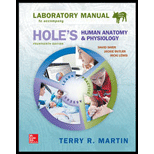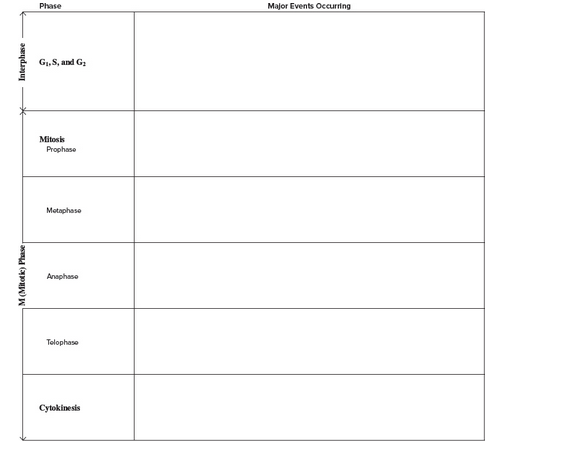
Concept explainers
Complete the table by listing the major events of each phase in the box. 
To write:
The major events occurring in different phases of a cell cycle.
Introduction:
A cell cycle is a sequence of events that involves growth and division of a cell in two daughter cells. The major stages of a cell cycle are mitotic phase,interphase and G0. The interphase includes G1, G2 and S phase whereas the mitotic phase includes prophase, metaphase, anaphase, telophase and cytokinesis.
Answer to Problem 1.1A
| Phase | Major events occurring | |
| Interphase | ||
| G1 | The cell grows physically. | |
| S | The DNA content duplicates in this phase. | |
| G2 | The cell prepares other cellular components required for mitosis. | |
| Mitotic phase | ||
| Mitosis | Prophase | 1. Chromosomes starts to condense at this stage. 2. Spindle fibers starts forming from two opposite poles 3. Nuclear envelope starts breaking. 4. Nucleolus starts to disappear. |
| Metaphase | 1. Sister chromatids attach to the spindle fibers through kinetochore. 2. Chromosomes line up at metaphase plate. | |
| Anaphase | 1. Spindle fibers that do not bind to the kinetochore, lengthens and elongates the cell. 2. Pulling of sister chromatids at opposite poles. | |
| Telophase | 1. Chromosomes that moved to opposite poles starts to decondense. 2. Nuclear envelope starts forming again around the chromosomes. 3. Spindle fibers starts to break down. | |
| Cytokinesis | Cytoplasm divides in this phase. a) In animal cell, the daughter cells are separated by formation of cleavage furrow. b) In plant cell, the daughter cells are separated by formation of cell plate. |
Explanation of Solution
Interphase is the growth and preparatory phase of a cell to undergo division. A cell is metabolically active during the G1 phase. The cell builds different molecular blocks, copies organelles and physically becomes larger.
Once the G1 phase ends, the cell enters the S phase. Replication of DNA occurs during this phase. The two copies formed are delivered to each daughter cells formed after cell division.
The G2 phase follows the S phase. It is also known as the second gap phase during which the cells prepare themselves to undergo the mitotic phase by synthesizing additional cellular components.
The interphase is succeeded by the mitotic phase. A cell undergoes Karyokinesis (mitosis) and cytokinesis during this phase. The mitosis includes the following events:
Prophase: The nuclear envelope starts to disintegrate to expose the condensed chromosomes in the cytoplasm. Spindle fibers start to emerge from the centrioles and bind with the sister chromatids at a site known as kinetochore. Nucleolus also disappears during the prophase.
Metaphase: The sister chromatids bound to the spindle fibers (originating from opposite poles) via kinetochore, are arranged at a central metaphase plate.
Anaphase: Cohesin protein that is responsible for binding the sister chromatids together, breaks down and the chromatids move to the opposite pole by the pull of attached spindle fibers. Spindle fibers that are not attached to the kinetochore, lengthens and elongates the cell.
Telophase: It is the final stage of mitosis that includes the formation of the nuclear envelope around the separated chromatids at opposite poles. The chromatids start to decondense and spindle fibers also break down.
The karyokinesis is followed by the cytokinesis that includes division of cytoplasm and the cell into two halves, each having the nucleus, cytoplasm and some organelles. In animal cells, cell furrow divides the two daughter cells whereas cell plate divides the two daughter cells in a plant cell.
Want to see more full solutions like this?
Chapter 7 Solutions
Laboratory Manual for Holes Human Anatomy & Physiology Fetal Pig Version
Additional Science Textbook Solutions
Biology Science Notebook
Genetics: Analysis and Principles
Campbell Essential Biology with Physiology (6th Edition)
Fundamentals of Anatomy & Physiology (11th Edition)
Anatomy & Physiology: The Unity of Form and Function
 Biology Today and Tomorrow without Physiology (Mi...BiologyISBN:9781305117396Author:Cecie Starr, Christine Evers, Lisa StarrPublisher:Cengage LearningHealth Safety And Nutrition F/Young ChildHealth & NutritionISBN:9781305144767Author:MAROTZPublisher:Cengage
Biology Today and Tomorrow without Physiology (Mi...BiologyISBN:9781305117396Author:Cecie Starr, Christine Evers, Lisa StarrPublisher:Cengage LearningHealth Safety And Nutrition F/Young ChildHealth & NutritionISBN:9781305144767Author:MAROTZPublisher:Cengage

